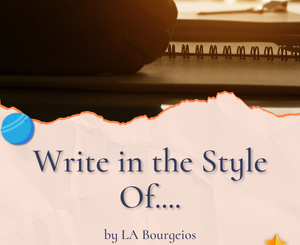Social Networking for Authors
Beth Barany uses social networking for her business and now incorporates it in her work as a creativity coach. In her talk, she provided excellent insight into this exciting and important way to build an author platform.
At the start, Beth collected people’s concerns, which consisted primarily of privacy and time wasting. “I’m a writer, I shouldn’t be doing tweets.” (Tweaks yes, tweets no.) Beth addressed these concerns and other minor ones as they arose.
Her first point was that social networking as an author means finding the right platform for you, not using everything that’s out there. And her final point was, how do you know if online social networking is for you? If it’s fun. If it isn’t fun for you, don’t do it! You can still use real-world networking and more traditional marketing such as postcards to announce your book.
[This post is based on a presentation I gave to the Silicon Valley Romance Writer’s of America chapter on September 26, 2009. Written by Nicci Carrera.]
What is Social Networking?
Beth discussed the meaning of social networking, for it is not confined to the Internet, of course. Examples of social networking included the very Silicon Valley RWA meeting in which we were participating as well as getting together with people for other professional meetings, such as writers’ conferences. All of these activities are social networking. They all represent opportunities to share information and gain connections. Social networking facilitates information between users. Online social networking is the same thing.
Before the Internet, people exclusively used things like postcards to get the word out about their new releases. Postcards are still a great thing to do even with the advent of the Net. The other great way books are sold, really the primary way books are sold, is by word of mouth. Think of using the Internet as word of mouse.
Now for some definitions. There’s a difference between social networking and marketing. Social networking’s purpose is to create connections, gather readers, and make friends. Marketing’s purpose is to tell people to buy your book. Marketing isn’t about conversation, it’s a one-way street. Social networking is two-way communication. Social networking involves a dialogue. People do business with people they know, like, and trust. An example of trust for authors is your consistent delivery on the promise of your brand. People will read your books because they know you are going to deliver on the goods, the emotional payoff.
Social networking provides an opportunity to expose yourself to a wider net (no pun intended). It tends to start off slowly and then grow exponentially. It’s good to build yourself up before you are published. The more people you can demonstrate are paying attention to you, the better catch you are to a publisher and agent. Marketing now is less advertisements and more conversation.
People are beginning to describe social networking as tribes. Your tribe includes your readers. Also, build on your existing tribe, like the people in our RWA chapter, to start your social-network foundation.
Social networking allows you to create a regular touch point with your fans and is an added component to our marketing as writers.
How to use Social Networking
There are ways that you can make it easy and simple. Definitely get the book, Webify Your Business, (listed at the end of this article). Beth referred to this resource quite a bit for any technical questions. I have purchased it and started working with it and I highly recommend it as a hard-hitting, practical guide. By hard-hitting, I mean the author Patrick Schwerdtfeger, makes an unequivocal case for growing your business through the Internet. He makes it easy, breaking it down into sequential steps that include identifying your value proposition and synthesizing what you are offering into an elevator pitch. As soon as I’m up on the Web, I’ll invite you to join my network on our Yahoo loop so you can see how a beginner fares with implementing the strategies in the book.
Back to Beth’s presentation. She suggests that if you choose to use the Internet before you are published, it’s good to choose a very broad brand, so you don’t limit yourself to a particular genre or type of book. “Aspiring Author” is a good one for starters.
To build your tribe, connect with other writers who write in your voice. Group blogs are great. If you write on a blog with authors who share a similar voice, readers of the blog will pick up your book too.
When you start to use Twitter, her tip for not being bored by people’s trivial posts, is to follow interesting people! On Twitter.com, you can follow book festivals, writers, editors… Follow an agent to see what your competitors are doing.
For privacy, on Twitter.com, you can block who follows you and you can use an alias.
The Uses of Twitter and Facebook
Beth uses Twitter to share what’s going on in the industry. Twitter allows you to connect with your readers and Facebook helps you engage your community.
One writer created a whole Facebook page about her fictional world. This example raised the question of how to protect that world. You can’t copyright an idea so be aware of that. Regarding copywriting, you can send your manuscript to the Library of Congress and you can also do it online at uscopyright.org. However, anything you create is copyrighted, by default.
Facebook can be used to share about your business, and what you are doing. Webify Your Business goes into this really well. Because this book offers an integrated approach to the Web, he has you plan what you are going to share on Facebook and on LinkedIn before you start.
Beth suggests talking to other authors who use Facebook and find out how they use it. For Facebook, the Profile page is more for personal stuff. You can create a Page for your business. The link to do so is in a box on the bottom of your Profile page. The Profile page should have some personal stuff. However, no one knew of anyone getting their Profile page canceled because it was strictly marketing. One author put the cover of her book on her Profile page.
If you have a blog, you can connect it to your Page. People can be a fan of your Page without being a friend.
Twitter is micro-blogging because it is limited to 140 characters. It has a real-time news feel to it. You can use it to share information. Use Twitter to create pass-along value. You can use it to communicate milestones. You can use it to talk about other authors.
Beth shines a light on other resources. In fact, being a resource is her brand. She tries to include a link in every tweet.
You can use LinkedIn.com to generate conversation. It’s more of a community for professionals. If you use Linked In, use groups. Gain visibility. Some groups are for writers and editors. You can find conversations there.
For blogging and online articles, you can write about writing. It’s something you know something about! Then, when you’re book comes out, you can say, “Oh by the way, I have a book coming out,” to your network.
On Facebook, do a fan page.
Before you start, be sure to save a domain name.
Time Strategies and Effectiveness Tips
For Twitter: Every day follow five more people that you like. Go to Beth’s Twitter account and check it out. See who she is following.
There’s an unwritten rule that about half the people you follow will follow you. Set a timer and try to follow five people in five minutes and post one tweet. Do this daily, or if that’s too much, do it once or twice a week. You can see what Beth has done. She creates tweets to be released later, at midnight and 6 a.m., which you can do by using Tweetlater.com. If you’re a working author, say something very interesting and specific about your book. Some author uses Tweets to create tension, for example saying, “I just had my hero get in a motorcycle accident, what do you think should happen next?” This draws people back and engages them in conversation.
Another thing to tweet are resources, like Beth does.
For Facebook, go on it once a month or once a week and post something. Go to the homepage, it’s everyone’s feed. Set your timer for 15 minutes and friend around. Friend a few people. See what people are saying on the general homepage. Note that when you go to people’s profiles or to the home feed, you can simply click a “like” button if you like what they have posted. Friend Beth on Facebook!
For Beth, marketing takes up about a quarter of her time while a quarter to a third of her time is spent creating content.
Branding
Know where you stand. People want to know your flavor. Romance writers want readers to have fun. Ask yourself why you write. Again, Romance writers have an overall brand of feeling good.
Whatever you write under, that’s your brand.
When you are online, keep your conversation in your brand. Also, keep your tweets professional.
Other Resources
There’s a Muse Online Writers conference in the second week of October. It’s probably filled up, but you might still be able to get in. It’s online, it’s free. There are publishers there, they take pitches, a lot goes on there. You can present also, by getting in touch with the organizer in advance.
Beth is part of a newsletter called Heart of the Bay. So is our SVRWA member, who doubles as president of the Black Diamonds chapter, Virna DePaul.
There are lots of articles on social networking.
RWA has a Facebook page. Yankee Romance Reviewers has chats with authors… There’s a lot available.
Ping.fm provides a single resource where you can post and it will be generated to all the social networking sites you have signed up for.
Check out Tribalauthor.com.
If you have questions, e-mail Beth at beth@bethbarany.com!
c. Nicci Carrera
More Resources
- beth@bethbarany.com
- www.bethbarany.com
- www.breakfastblogging.com (Beth’s blog and workshops with a colleague, Cheryl Liquori)
- Webify Your Business: Internet Marketing Secrets for the Self-Employed, Patrick Swerdtfeger.
- www.webifybook.com.
- Twitter.com
- Tweetlater.com (now Socialoomph)
- Hootsuite.com
- www.Tweetdeck.com
- Facebook.com
- LinkedIn.com
- Ping.fm
- YouTube.com







“Social Networking For Authors” would make a great (timely) ebook.
Hi Noel, And excellent idea! Thanks!